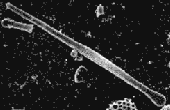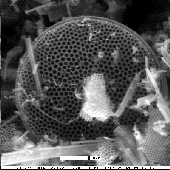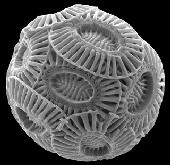|
 See More Images See More Images

Sceptroneis caduceus
© 1995 UCMP

Unknown diatom (cingulum)
© 1997 UCMP

Emiliania huxleyi
© 2003 Jeremy R. Young, Natural History Museum, London
|
What are Protists? The term “protist” refers to any eukaryote that is not a plant, animal, or fungus. Most protists are unicellular, while others are multicellular or even multinucleate (many nuclei in one cell). Some live as single individuals, others as colonies. This diverse group exhibits a wide variety of sizes, shapes, life cycles, habitats, and feeding and reproductive strategies. The protists have a long, although in some cases patchy, fossil record stretching back to the Precambrian. First known fossil occurrence: Precambrian. Last known fossil occurrence: Quaternary. This group has living relatives. |
Fossils through time:
Choose a time period to see what life was like:
|
|